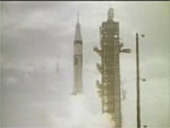Space Stations - I
 When astronaut Neil Armstrong stepped onto the moon in 1969,
the U.S. won the last leg of the space race. The end of the race
meant a big change for the future of space exploration.
When astronaut Neil Armstrong stepped onto the moon in 1969,
the U.S. won the last leg of the space race. The end of the race
meant a big change for the future of space exploration.
Putting humans on the moon cost a huge amount of money. Once the U.S. won the race, the government began to give NASA less money. And in the early 1970s, there was less tension between the U.S. and the Soviet Union.
The new goal of the two countries' piloted space programs was to live in space but stay close to home.
Salyut
 In April 1971, the Soviet Union launched the world's first space
station: Salyut 1.
In April 1971, the Soviet Union launched the world's first space
station: Salyut 1.
The first Salyut space stations were made up of a single, long, round module.
These early stations were designed for short missions. They had only one docking port. This meant that they could not be resupplied or refuelled while a crew was onboard.
Soviet cosmonauts used a Soyuz spacecraft to travel to and from the space station. Each crew had three members.
Unfortunately, the early Salyut program had a lot of problems and even a tragedy. The first crew sent to Salyut 1 could not enter the station. The docking mechanism did not work, so they were forced to return home.
The second crew was able to enter the station, and they lived aboard it for 22 days. But as they re-entered Earth's atmosphere, their Soyuz capsule depressurized. All three crew members were killed.
 The next three Salyut stations failed to reach orbit or broke
up in orbit before crews could be sent to them. However, the
program quickly recovered.
The next three Salyut stations failed to reach orbit or broke
up in orbit before crews could be sent to them. However, the
program quickly recovered.
Five crews visited Salyut 3, 4, and 5 between 1974 and 1977. The last Salyut station, Salyut 7, was launched in 1982 and stayed in orbit for about 9 years.
Skylab
The United States entered the age of the space station on May 14, 1973. On that date, NASA launched Skylab. The station was built from the third stage of a Saturn V moon rocket.

|

|
 Launch of the first crew to visit Skylab, and their approach to the station. NASA video.
Launch of the first crew to visit Skylab, and their approach to the station. NASA video.
|
 Three groups of astronauts visited and worked on Skylab. They went
back and forth to the station in Apollo capsules, much like in the
moon missions. The three-person teams spent a total of 171 days in
space.
Three groups of astronauts visited and worked on Skylab. They went
back and forth to the station in Apollo capsules, much like in the
moon missions. The three-person teams spent a total of 171 days in
space.
 Skylab's main purposes were to study the sun and Earth. The astronauts
used a number of different space telescopes to view and photograph
events such as solar flares.
Skylab's main purposes were to study the sun and Earth. The astronauts
used a number of different space telescopes to view and photograph
events such as solar flares.
They studied the Earth's crust, oceans, and weather. They also studied
how the body, mind, and materials react to long periods of
weightlessness.
 A spacewalk, exercise, and undocking at Skylab. NASA video.
A spacewalk, exercise, and undocking at Skylab. NASA video.
|
 Problems plagued Skylab in its early days. During launch, a protective
shield was torn away. The shield damaged a solar panel that was needed
for electrical power.
Problems plagued Skylab in its early days. During launch, a protective
shield was torn away. The shield damaged a solar panel that was needed
for electrical power.
And a heavy workload caused stress for the astronauts. These problems challenged the skills, knowledge, and ingenuity of the whole NASA team.
 Despite the problems, Skylab was considered to be a great success. The
astronauts carried out almost 300 scientific, technical, and medical
experiments.
Despite the problems, Skylab was considered to be a great success. The
astronauts carried out almost 300 scientific, technical, and medical
experiments.
Many of these experiments simply could not be carried out on Earth due to the presence of gravity. And Skylab proved that American astronauts could live and work in space for extended periods.
Skylab was not designed to stay in space for a long time. By the late 1970s, the station was starting to fall out of its orbit.
On July 11, 1979, Skylab plummeted through Earth's atmosphere. Pieces of the station fell in the Australian desert and into the Indian Ocean.
Learn more about the Skylab program.